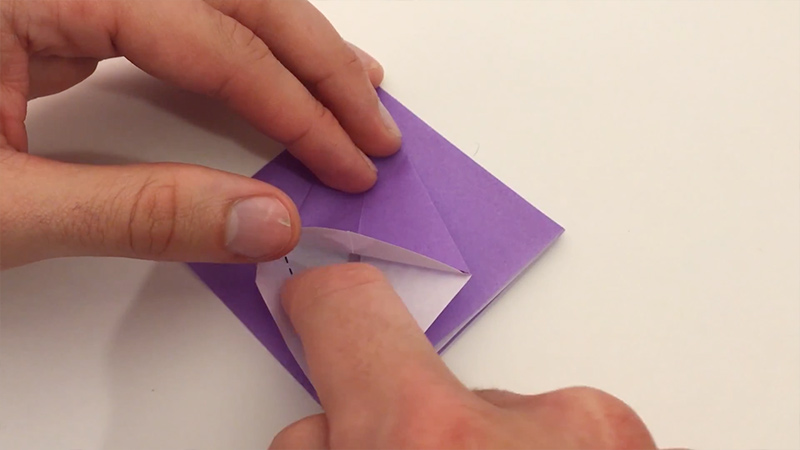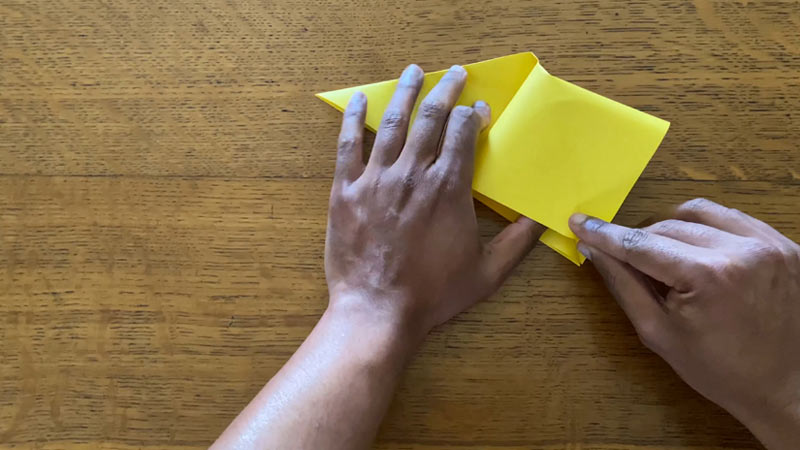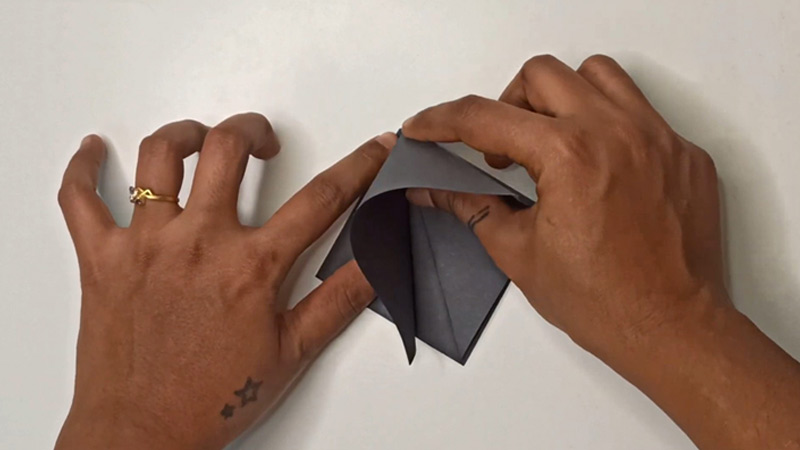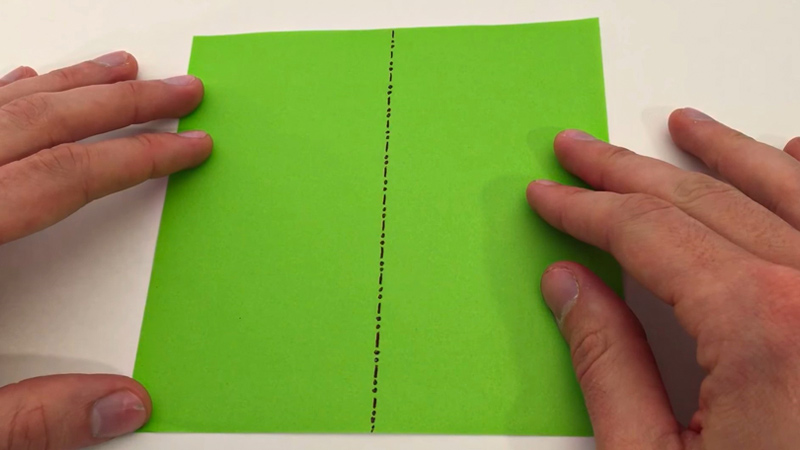Origami, the ancient Japanese art of paper folding, encompasses a myriad of intricate folds and techniques that transform a simple sheet of paper into awe-inspiring creations.
One such technique that adds depth and dimension to origami designs is the “Squash Fold.” In this exploration, we delve into the essence of the squash fold, unraveling what a squash fold is in origami and understanding its significance in the world of paper folding.
The Squash Fold is a versatile maneuver that involves flattening a portion of the paper to create new surfaces and angles.
This seemingly straightforward fold holds the power to enhance the realism and complexity of various origami creations, allowing artists to breathe life into their paper sculptures.
Join us on a journey through the folds and creases as we demystify the art of the Squash Fold, unlocking its potential for both novice and seasoned origami enthusiasts alike.

What Is A Squash Fold In Origami?
The Squash Fold stands out as a versatile and essential maneuver among the myriad folding techniques that bring life to origami creations. Let’s explore the intricacies of the Squash Fold, uncovering its history, mastering its execution, and discovering its transformative impact on origami art.
Origins and Evolution
The roots of origami trace back to ancient Japan, where the art form gained prominence as a cultural and spiritual practice.
Over the centuries, origami artists have innovated and expanded the repertoire of folding techniques, with the squash fold emerging as a fundamental and transformative method.
Fundamentals of the Squash Fold
At its core, the Squash Fold involves flattening a portion of the paper to create new surfaces and angles. The dynamic and adaptable technique serves as a foundation for more complex folds. Understanding its fundamentals is crucial for any origami enthusiast looking to elevate their creations.
Applications in Various Models
The Squash Fold is not limited to a specific origami model but is a versatile technique applied across various designs. Whether you’re folding animals, geometric shapes, or intricate figures, mastering the Squash Fold enhances your creations’ realism and aesthetic appeal.
The Artistic Impact of the Squash Fold

Now that you know what a squash fold is, let’s explore its value. Here’s how Squash Fold origami contributes to the overall art:
Adding Realism to Origami
One of the remarkable qualities of the Squash Fold is its ability to add realism to origami models. This technique transforms flat surfaces into three-dimensional shapes by creating additional layers and contours, making the paper creations more lifelike and engaging.
Enhancing Complexity
Origami artists often use the Squash Fold to introduce complexity and intricacy into their designs. By incorporating multiple origami Squash Fold techniques or combining them with other techniques, artists can create visually stunning and elaborate origami sculptures.
Expressing Creativity
Beyond its technical aspects, the Squash Fold is a canvas for artistic expression. Origami enthusiasts are encouraged to experiment with different variations of the fold, infusing their unique style and creativity into traditional designs.
The Squash Fold becomes a tool for self-expression within the structured world of origami.
Overcoming Challenges and Refining Skills
Are you trying origami with Squash paper and folding techniques? Here’s how to overcome the challenges:
Precision and Patience h4
As with any origami technique, precision is key to mastering the Squash Fold. Take the time to ensure accurate creases and smooth folds, which will significantly impact the final result. Patience is a virtue in origami, and refining the Squash Fold technique requires practice and dedication.
Experimentation and Iteration
Origami is an evolving art form, and artists are encouraged to experiment with the Squash Fold. Try applying the fold to different model sections, explore variations, and discover how it can be combined with other techniques to achieve unique and captivating results.
Inspiring Examples and Projects
Create a captivating menagerie of animals using the Squash Fold. From elephants to birds, the technique brings a level of realism that captures the essence of these creatures.
Explore the world of origami architecture by incorporating the Squash Fold into your designs. Transform flat paper into intricate buildings, bridges, and structures, showcasing the versatility of this technique.
How to Do a Squash Fold?

A squash fold is a fundamental origami technique that flattens a paper model by combining two opposite sides. Follow these Squash Fold origami steps to create an origami piece:
Choose Your Paper
Select a square piece of origami paper. Cut a square from regular paper if you don’t have origami paper. Fold the paper in half diagonally, creating a triangle. Unfold the paper to reveal the crease, forming an X.
Create a Square Base
Fold the paper in half horizontally and vertically, aligning the edges with the center crease. Unfold the paper after each fold. Bring the top edge down with the open flaps facing up to meet the bottom edge. Press the sides in to collapse the paper into a square shape. This is called the preliminary base.
Perform the Squash Fold
Open the top layer of the preliminary base, lifting one of the triangular flaps. Hold the sides of the flap and gently pull them apart, creating a pocket. Press down on the top while maintaining the pocket shape, squashing the flap flat.
Repeat the Squash Fold
Flip the paper over to the other side. Open the top layer, lifting one triangular flap. Create a pocket and squash the flap down again, forming a square.
Rotate and Repeat
Turn the paper 90 degrees and perform the squash fold on the remaining two flaps. Now, you should have a smaller square with four flaps sticking out.
Create Petal Folds
Lift and fold one flap diagonally, aligning the edge with the center crease. Repeat for the remaining three flaps. This results in a shape resembling a four-petaled flower.
Perform Another Squash Fold
Open one of the petals, exposing the layers beneath. Create a pocket by lifting the top layer, then squash it flat. Perform the squash fold on the other three petals, one at a time.
Finalize the Model
Adjust the folds to make the model symmetrical and neat. You can shape the petals and refine the overall appearance. Experiment with different paper sizes and colors to create unique variations of origami models using the squash fold technique.
Practice Makes Perfect
Origami requires practice, so don’t be discouraged if your first attempts aren’t perfect. You’ll improve your precision and technique as you become more familiar with the folds.
Remember, these instructions provide a general guide for creating an origami piece with squash folds. Feel free to adapt and explore, adding your creative touch to the process.
What Are Some Other Popular Folds in Origami?
Here are some popular origami folds that add versatility and complexity to your creations:
Valley and Mountain Folds

Valley Fold requires folding the paper towards you, creating a “V” shape with the crease pointing down. Mountain Fold means folding the paper away from you, forming an upside-down “V” with the crease pointing up.
Preliminary Fold and Sink Fold
Sink Fold creating a pocket in the paper by collapsing a square or triangular region, often used to hide excess paper or add detail.
Preliminary Fold is folding the paper in half horizontally and vertically, creating a preliminary base that is the starting point for many origami models.
Inside and Outside Reverse Folds
Inside Reverse Fold is folding a section of the model inside, reversing the existing creases. On the other hand, the Outside Reverse Fold requires folding a section of the model outside, creating a new layer.
Swivel Fold and Blintz Fold
Swivel Fold is a rotational fold that allows parts of the model to pivot, creating dynamic and movable elements. Blintz Fold is folding the corners of a square into the center point, resulting in a smaller square within the larger square.
Bird Base and Waterbomb Base
Bird Base is a foundational base used for various origami models, including birds. It involves a series of valley and mountain folds to create a square with flaps.
Waterbomb Base is a base formed by folding the paper into a preliminary base and then performing additional valley and mountain folds to shape it into a cube.
Kite Base and Rabbit Ear Fold
Kite Base creates a kite shape by folding a square diagonally and then unfolding it, revealing a cross pattern. This base is often used in modular origami.
Rabbit Ear Fold folds a corner of the paper to resemble a rabbit ear, creating triangular flaps that can be manipulated further.
FAQs
What types of origami models benefit the most from the Squash Fold?
The Squash Fold is highly versatile and can enhance various origami models. It is particularly beneficial for creating realistic animal figures, adding depth to geometric shapes, and introducing complexity to intricate designs like flowers or modular origami projects.
Are there alternative folds similar to the Squash Fold?
Yes, several folds share similarities with the Squash Fold. Notable examples include the Petal Fold and the Open Sink. While each has its unique characteristics, they all involve manipulating the paper to create new layers and dimensions, contributing to origami models’ overall complexity and realism.
How do I prevent paper tearing while executing the Squash Fold?
To minimize the risk of paper tearing, it’s essential to use high-quality origami paper that is neither too thin nor too thick. Additionally, ensure that your creases are well-defined but not excessively sharp.
Can I combine the Squash Fold with other folding techniques?
Absolutely! Combining the Squash Fold with other folding techniques opens up a world of creative possibilities. Experiment with layering multiple squash folds, incorporating sinks and swivels, or integrating it with other advanced folds to create intricate and visually stunning origami designs.
How do I adapt the Squash Fold for complex origami projects?
For complex origami projects, approach the Squash Fold with patience and precision. Break down the model into smaller sections, gradually applying the Squash Fold to each part.
Conclusion
The Squash Fold stands as a testament to the ingenuity and versatility embedded within the art of origami. As we’ve explored its intricacies, it becomes evident that this fold is more than just a technique; it’s a gateway to unlocking the expressive potential of paper.
Origami enthusiasts, from beginners to seasoned artists, can harness the power of the Squash Fold to breathe life into their creations, adding depth, dimension, and a touch of realism.
Beyond its technical aspects, the Squash Fold embodies the spirit of innovation within the origami community. It encourages artists to experiment, push boundaries, and infuse their unique flair into traditional designs.
The journey through the folds of origami, with the Squash Fold as our guide, reminds us that within the simplicity of paper, a world of artistic expression awaits.
Leave a Reply